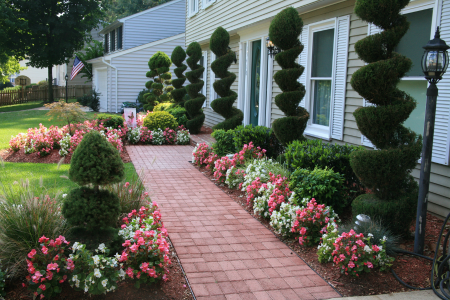New homeowners are likely eager to make updates to create a more personalized space. Although there is plenty of time for changes, there are a few landscaping projects you will want to start immediately.
Here is why you should consider landscaping in the first year, how to set a budget, and what projects have the best returns on investment (ROI).
Why Should New Homeowners Tackle Landscaping Projects Immediately?
Landscaping in the first year is an opportunity to assess your yard. Which areas receive the most sunlight? What are the soil conditions? How is the drainage? These factors are crucial for deciding which outdoor projects to tackle first.
Sprucing up your yard is a great way to put your stamp on your new home. While it may be early to think about selling again in the future, updating and maintaining your home’s curb appeal will result in a higher resale value.
Of course, customizing your outdoor space allows you to enjoy it more. Perhaps you dream of dining alfresco or relaxing on the patio in the afternoon. Setting up this space will help you get settled in even faster.
How Much Should You Spend on Landscaping?
You will accrue several additional costs when you move into a new home. Therefore, it is a good idea to have a budget set aside for landscaping. Most homeowners spend $1,261-$6,028 on outdoor projects, but it depends on the size of your yard, the cost of labor, current lawn conditions, and the type of landscaping you want.
Experts recommend spending at most 10% of your home value on front and backyard landscaping.
8 Landscaping Projects to Do in the First Year
With a set budget and vision for the ultimate yard, you can begin planning your landscaping upgrades. These eight projects are ideal first steps for an immaculate and inviting property.
1. Plant Trees
Planting trees enhances your property’s visual appeal and improves heating and cooling costs. Naturally, tree placement is critical. Plant them on your yard’s north and northwest sides to protect your home from winter weather.
Removing and relocating trees may be necessary if they are too close to the house since they could damage your roof or foundation. Early spring or fall is best for transplanting trees due to their dormant state, which protects them during the process.
2. Create Garden Beds
Adding pops of color with flowers makes your home more welcoming. Create garden beds in the spring to keep your flowers contained and your yard well-manicured.
You may even place a tree in the center of your garden bed or install a border with pavers. Likewise, consider constructing a retaining rock wall with a garden if your lawn slopes.
3. Maintain the Lawn
New homeowners will want to strive for a green, lush lawn. However, this requires regular maintenance. Maintaining it yourself takes time — or you can hire professionals to do it for you.
According to the 2023 Remodeling Impact Report: Outdoor Features by the National Association of Realtors, most people see a 217% cost recovery on lawn care services. A healthy yard also has a joy score of 9.4 on a scale of 1-10.
4. Add Hardscaping
Hardscaping projects — stone or gravel walking paths, stepping stones, brick pavers, and cobblestone patios — add structure to your property. They are also helpful in breaking up a large lawn for easier care.
The hardscape materials you choose should match your home and style for a seamless appearance. For example, you might incorporate terra cotta, colorful tiles, and pea gravel into a Mediterranean-style garden.
5. Consider Xeriscaping
Xeriscaping is a good alternative if you have little time to maintain your yard or live in an area with prolonged droughts. Include native plants adapted to your region, as they require less irrigation. Other drought-tolerant flora could include daffodils, cacti, and lavender.
Nearly 30% of residential water consumption in American households goes toward lawn care — equal to 9 billion gallons. Many homeowners opt for xeriscaping to reduce their water bills significantly.
6. Add Outdoor Living
Fixr.com’s Outdoor Living Trends Report 2023 says a usable exterior is very important or important to 60% and 36% of homeowners, respectively.
Extending your patio, installing a deck, or adding an outdoor kitchen may cost more than the average landscaping budget but will be well worth the price for personal enjoyment. Adding a wood deck can bring a 64.8% return on investment.
7. Lay New Mulch
A fresh layer of mulch is one of the easiest ways to set your home’s atmosphere in the first year. Costs vary depending on the grade you use and how much of your yard you must cover.
Mulching in the springtime will also jumpstart your property’s overall health by improving soil temperatures, reducing erosion, and decreasing weeds. It also retains more moisture, preventing evaporation and the need for frequent watering.
8. Add a Sprinkler System
A sprinkler system could cost you $1,679-$3,541 but may be a necessary investment. It has an 86% ROI.
Oversaturation could hinder plant growth and cause root rot. An automated system lets you control your sprinkler schedule using your smartphone, saving money, preventing overwatering, and protecting your plants.
Feel More at Home with Fresh Landscaping
Landscaping can make you feel more at home whenever you pull into the driveway. Invest time and money into sprucing up your new yard. The outcome will increase your comfort, aesthetics, and ROI.

